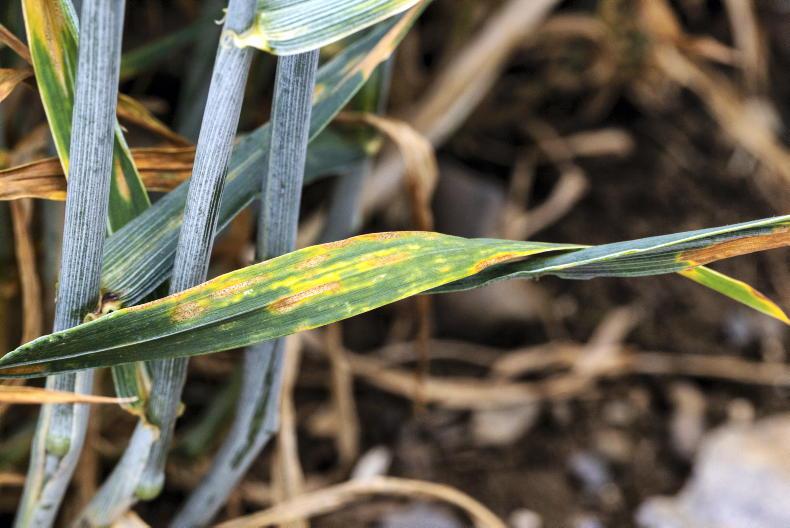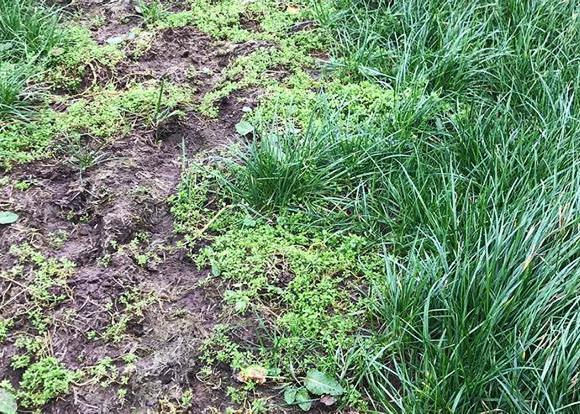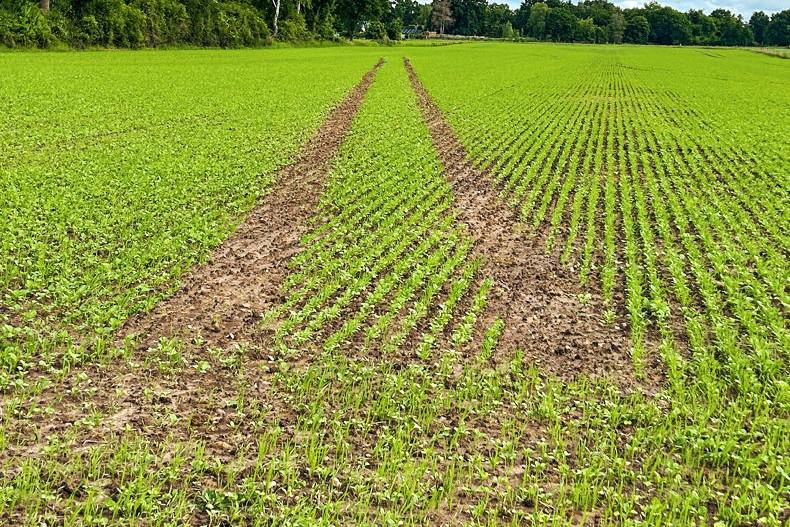Seaforde,
Co Down

Neill Patterson
It has been difficult to get harvesting done in Down, with Neill describing the harvest as “smash and grab”, with every opportunity to get some field work done being taken.
He did manage to finish the winter wheat harvest on Friday after starting a couple of weeks ago. Neill still has 30ac of straw on the ground that will need to be raked before baling once the weather dries up again.
Neill is happy overall with his yields considering the tough weather this year. The KWS Extase looked like a great crop all year despite the BYDV in the crop, but it failed to deliver compared to the Graham.

Neill cutting Graham winter wheat last week.
The KWS Extase averaged 4t/ac at a KPH of 73. The Graham gave an exceptional yield at 4.7t/ac at a KPH of 77. The average moisture content was 18%. The straw yields averaged 5.5 8x4x3 square bales per acre.
All the straw has been sold out of the field and Neill says there has been a very high demand for straw in his area. Neill will subsoil some of the deep tramlines once the fields are cleared.
The spring beans are about a fortnight away from harvest. Neill says they look promising, with more pods than last year. He is hoping for some good weather to ensure an easy harvest.
The maize cobs have germinated well and are beginning to fill out. Neill thinks that harvest will be at the end of September or the start of October.
The stubble turnips planted after winter barley have had a lot of slug damage. Neill says that the slugs came in over night and cleared out most of the plants on 30% of the planted area over the course of two days.
Neill doesn’t know whether slug pellets would have helped and he thinks that they wouldn’t be economically viable considering that it is only a secondary crop for grazing.
Street, Co Westmeath

MFW Alex Butler
Ground has got wet in Westmeath, leading to a struggle to get trailers out of one or two fields. Despite this, Alex has finished cutting winter wheat.
He is disappointed with a good proportion of it, with 3.5t/ac being a good crop in his area this year.
He is not sure whether it was the dull weather at grain fill or disease that was the main issue, but he says a couple of grassy fields where the herbicide was not fully effective did not help.
At this stage he is just happy to have the fields cut and most of the straw has been baled.
Alex started cutting organic spring oats last week and they seem to be doing very well, with yields around 2t/ac.

The male rows in Alex's spring oilseed rape have been topped. This allows the remaining female rows to be harvested for hybrid seed production.
There are not too many weeds in the crop so harvesting is pretty straightforward. He hopes to finish these oats this week.
The spring barley is only starting to come ripe and it will be the weekend before Alex makes a start on it.
Alex ploughed and drilled winter oilseed rape at the end of last week into good conditions. He is sticking with the variety PT303 this year as it has performed well for the farm.
Alex applied slug pellets on Tuesday due to high slug pressure this year.
The spring oilseed rape being grown for seed has had the male rows topped to prevent seed formation. Alex says it looks like a nice crop but it won’t be ripe until October.
The spring beans are in the same boat and are very green.
Ten per cent of the beans have broken over half way up the stem in the strong winds and rain in the past couple of weeks.
The maize, however, is proving a nice surprise for Alex as it has done very well in the past month and he is hoping for a good yield.
In one field there is some volunteer oilseed rape having an effect despite a herbicide being applied.
O’Shea Farms, Piltown, Co Kilkenny

Tom Murray new headshot
The harvest has progressed well in Kilkenny, with about one third of spring cereals remaining. Most of this is fit to be cut except for one block of oats that is ten days away. No spring oats have been cut yet as the focus is on spring barley.
Tom got an extra combine in over the weekend to lend a hand so a lot of barley was cut. The continuous spring barley is yielding between 2.8 and 3t/ac, while the barley after break crops is between 3.25 and 3.5t/ac. All the spring barley is Geraldine. It is being cut at between 16 and 20.5% moisture, with bushel weights around 65KPH. There is also a plentiful swarth of good quality straw, and much of this has been baled. Tom says it was a good growing season for spring barley with low BYDV levels and the crops have been cut so far with very little brackling.

The Maris Piper potatoes are being topped this week in preparation for harvest.
Tom says the windows for harvesting are getting shorter as we move into September and the days become shorter so he is hoping for some good weather to get the spring cereals wrapped up.
All the salad potato haulms have now been destroyed, as well as two thirds of the Rooster crop. All of the Maris Piper fields will be done this week. Spotlight Plus (1l/ha) and Ranman Top (0.5l/ha) are then applied before a follow up application of Spotlight Plus (0.6l/ha) seven days later.
Carrots continue to be harvested. After harvest, a cover crop is planted to cover the soil and improve soil structure. This may be a grass-type cover crop for grazing or silage, or a mixed-species cover crop.
The maize is still very green. Tom says it has made a great recovery over the past number of weeks and it looks like it should provide a decent yield considering how late it was planted and the harsh weather it endured in June.
He notes that sheltered fields seem to be performing much better.
Seaforde,
Co Down

Neill Patterson
It has been difficult to get harvesting done in Down, with Neill describing the harvest as “smash and grab”, with every opportunity to get some field work done being taken.
He did manage to finish the winter wheat harvest on Friday after starting a couple of weeks ago. Neill still has 30ac of straw on the ground that will need to be raked before baling once the weather dries up again.
Neill is happy overall with his yields considering the tough weather this year. The KWS Extase looked like a great crop all year despite the BYDV in the crop, but it failed to deliver compared to the Graham.

Neill cutting Graham winter wheat last week.
The KWS Extase averaged 4t/ac at a KPH of 73. The Graham gave an exceptional yield at 4.7t/ac at a KPH of 77. The average moisture content was 18%. The straw yields averaged 5.5 8x4x3 square bales per acre.
All the straw has been sold out of the field and Neill says there has been a very high demand for straw in his area. Neill will subsoil some of the deep tramlines once the fields are cleared.
The spring beans are about a fortnight away from harvest. Neill says they look promising, with more pods than last year. He is hoping for some good weather to ensure an easy harvest.
The maize cobs have germinated well and are beginning to fill out. Neill thinks that harvest will be at the end of September or the start of October.
The stubble turnips planted after winter barley have had a lot of slug damage. Neill says that the slugs came in over night and cleared out most of the plants on 30% of the planted area over the course of two days.
Neill doesn’t know whether slug pellets would have helped and he thinks that they wouldn’t be economically viable considering that it is only a secondary crop for grazing.
Street, Co Westmeath

MFW Alex Butler
Ground has got wet in Westmeath, leading to a struggle to get trailers out of one or two fields. Despite this, Alex has finished cutting winter wheat.
He is disappointed with a good proportion of it, with 3.5t/ac being a good crop in his area this year.
He is not sure whether it was the dull weather at grain fill or disease that was the main issue, but he says a couple of grassy fields where the herbicide was not fully effective did not help.
At this stage he is just happy to have the fields cut and most of the straw has been baled.
Alex started cutting organic spring oats last week and they seem to be doing very well, with yields around 2t/ac.

The male rows in Alex's spring oilseed rape have been topped. This allows the remaining female rows to be harvested for hybrid seed production.
There are not too many weeds in the crop so harvesting is pretty straightforward. He hopes to finish these oats this week.
The spring barley is only starting to come ripe and it will be the weekend before Alex makes a start on it.
Alex ploughed and drilled winter oilseed rape at the end of last week into good conditions. He is sticking with the variety PT303 this year as it has performed well for the farm.
Alex applied slug pellets on Tuesday due to high slug pressure this year.
The spring oilseed rape being grown for seed has had the male rows topped to prevent seed formation. Alex says it looks like a nice crop but it won’t be ripe until October.
The spring beans are in the same boat and are very green.
Ten per cent of the beans have broken over half way up the stem in the strong winds and rain in the past couple of weeks.
The maize, however, is proving a nice surprise for Alex as it has done very well in the past month and he is hoping for a good yield.
In one field there is some volunteer oilseed rape having an effect despite a herbicide being applied.
O’Shea Farms, Piltown, Co Kilkenny

Tom Murray new headshot
The harvest has progressed well in Kilkenny, with about one third of spring cereals remaining. Most of this is fit to be cut except for one block of oats that is ten days away. No spring oats have been cut yet as the focus is on spring barley.
Tom got an extra combine in over the weekend to lend a hand so a lot of barley was cut. The continuous spring barley is yielding between 2.8 and 3t/ac, while the barley after break crops is between 3.25 and 3.5t/ac. All the spring barley is Geraldine. It is being cut at between 16 and 20.5% moisture, with bushel weights around 65KPH. There is also a plentiful swarth of good quality straw, and much of this has been baled. Tom says it was a good growing season for spring barley with low BYDV levels and the crops have been cut so far with very little brackling.

The Maris Piper potatoes are being topped this week in preparation for harvest.
Tom says the windows for harvesting are getting shorter as we move into September and the days become shorter so he is hoping for some good weather to get the spring cereals wrapped up.
All the salad potato haulms have now been destroyed, as well as two thirds of the Rooster crop. All of the Maris Piper fields will be done this week. Spotlight Plus (1l/ha) and Ranman Top (0.5l/ha) are then applied before a follow up application of Spotlight Plus (0.6l/ha) seven days later.
Carrots continue to be harvested. After harvest, a cover crop is planted to cover the soil and improve soil structure. This may be a grass-type cover crop for grazing or silage, or a mixed-species cover crop.
The maize is still very green. Tom says it has made a great recovery over the past number of weeks and it looks like it should provide a decent yield considering how late it was planted and the harsh weather it endured in June.
He notes that sheltered fields seem to be performing much better.















SHARING OPTIONS